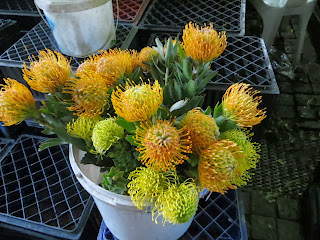I have no
problem with Heritage Day turning into Braai Day. After all, cooking over a
fire goes back to the days when man first discovered that fire might make his
food taste better and cuts across many cultural boundaries - that's quite a heritage to celebrate. But I do believe that we still have a lot of work to do in order to get to know each other in this country.
In that spirit I
was happy to see that Footsteps to Freedom City Walking Tours had joined IzikoMuseums and the Taj Hotel to
offer free walks exploring the places of historical significance in the city
centre during Heritage week. It seemed an
appropriate way to spend Heritage Day and I invited an Australian visitor along. I was pleasantly surprised to see that the crowd of
about 40 people who turned up consisted of mostly South Africans, eager to learn more of
their own heritage.
 |
| Traders on Greenmarket Square |
 |
| Old Town House |
We started off
in Greenmarket Square, the second oldest public space after the Grand Parade,
which served as a general meeting place and where water was collected from the
public water pump which stood in the centre of the square. I didn’t know that
the front door of the Old Town House, which stands on the edge of the square,
is the place from which you measure distance in Cape Town.
 |
| Pincushion Proteas or Waratahs |
Next was the
colourful flower market, Trafalgar Place, where there were beautiful pincushion
Proteas on sale. My Australian friend pointed out that she knew them by a
different name back home – Waratahs (yes, the name of one of their rugby teams).
 |
| The City Hall |
 |
| The Bell tower of the Groote Kerk |
 |
| The Slave Memorial on Church Square |
A slave memorial, consisting of slave names engraved on marble slate, has been erected on Church Square. Slaves socialized here while their owners attended church services in the Groote Kerk. Opposite the memorial and church is The Slave Lodge which housed slaves, convicts and political prisoners between the 17th and 19th centuries.
 |
| Government Avenue used to be the place to see and be seen. |
Our walk continued down Government
Avenue past Tuynhuis where guests of the colony used to stay and which is now the president’s
office. A blocked-up water channel which
was originally dug by slaves runs in front of this house. We were reminded that
the fresh water which runs down from Table Mountain was the main attraction of the
Cape as a halfway stop on the way to the east. It seems a pity that we are not
harnessing this water for use instead of letting it all flow into the sea.
 |
| View of Table Mountain from the Company Gardens |
 |
| Statue of Sir George Grey in front of National Library |
The statue of
Governor George Gray is the first statue of a person to be erected at the Cape. At the
end of his term he donated his books to start the National Library.
Our guide was knowledgeable and fed us many interesting tidbits like the fact that the floor of the Groote Kerk was originally sand so that it could be dug up in order that members of the congregation could be buried there.
I highly recommend this tour to locals and visitors alike. It was a worthwhile way to spend two hours.
I highly recommend this tour to locals and visitors alike. It was a worthwhile way to spend two hours.




No comments:
Post a Comment